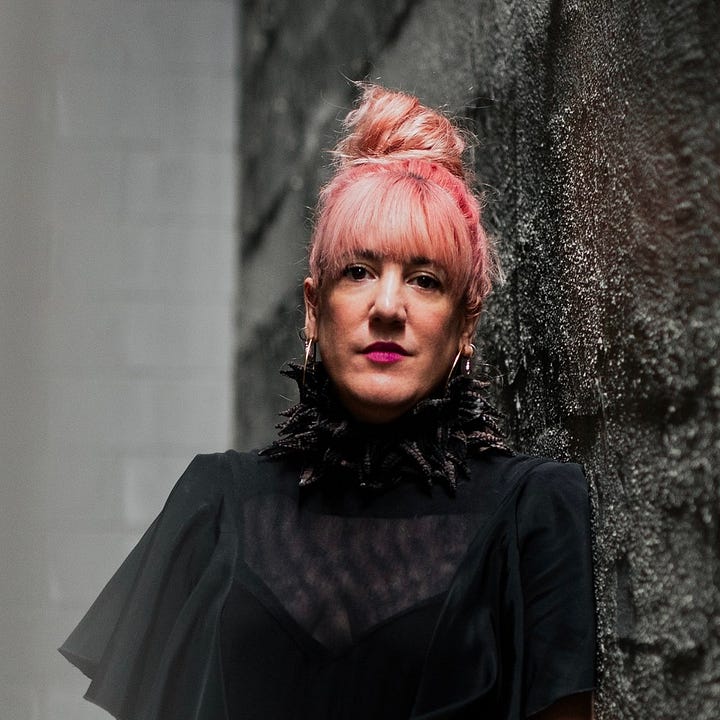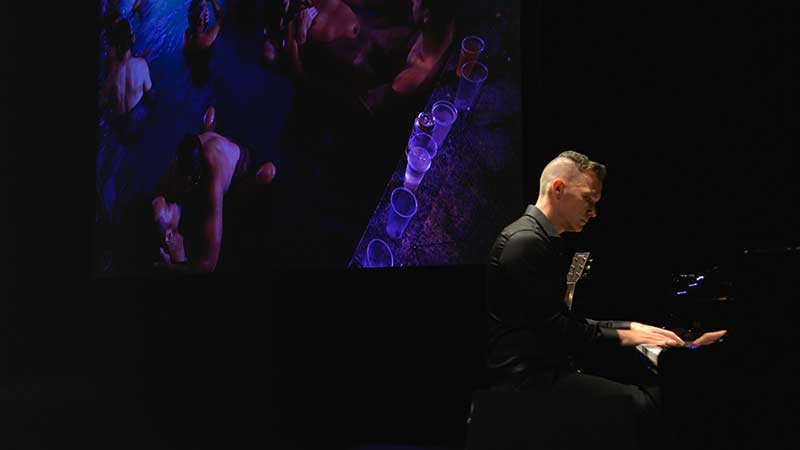Resonance | Interview: Timothy Fairless
Composers Timothy Fairless & Madeleine Cocolas in Conversation


Good friends and composers Timothy Fairless and Madeleine Cocolas have a cross continental chat about their latest album releases, Timothy’s Keep Talking to Me (out now via Dragon’s Eye Recordings) and Madeleine’s Syndesis (out now on Room40).
Timothy Fairless (TF): Hey Madeleine! I think second person could work quite well for this, don’t you think? I’m meshing well with the idea of a coherent but approachably rambling back and forth. Might be humanising? And at this point in everyone’s digitally mediated existence, isn’t “breaking the rules a bit” more fun to read? Where did that fourth wall go anyway?
This leads us (conveniently) into a common (and complimentary) thread I can stitch between both your upcoming album, and mine. Consistent in both of our practices over time is a process of mining our own histories to bring context to our present. It’s not an unusual method for artists, but what I find personally interesting about a lot of modern music-making is that it’s become utterly reliant on technology for its production. On your album, Syndesis, you’ve used technology to capture fragments of a place full of antiquities (contemporary digital recordings of your ancestral homeland of Greece), and used them as a vehicle to consider your relationship to your past. On my album, Keep Talking to Me, I used the capture of a previous time on antiquated technology (the late 1990’s, on video tape) as a vehicle to consider how we interact with our present (and perhaps our future).
Of course, these ideas come alive as we edit, manipulate and augment but I’m curious as to how the technology we used at the source – or our experience of our interaction with it – influenced our creative pathways.
Much of the underlying audio on my new album is lifted from analogue home video recordings nearly 30 years old. The character of these has a particular myopia, in that the audio and visual spectrum is constricted. The consumer-grade camera couldn’t capture wide angles or immersive depth-of-field. The result is a partitioning of the experience of the people on these videos. All that remains is a poor-quality reconstruction of a time I recall as exciting and vibrant – a photocopy of a photocopy. This connected me directly to exploring concepts on the album of how much of our human-to-human interaction is mediated by increasingly complex technologies, and the barrier that places between what we want to say, and how we’re understood.
How do you think your experience of capturing the source recordings in Greece for your new work shaped the subsequent process, and how the album turned out?
Madeleine Cocolas (MC): Hey Timothy, what a fantastic way to open this conversation!
I find it really interesting that both our albums share the similarity of using ‘lo-tech’ ways of capturing the sounds on which they are built. Whilst you mined your analogue home video recordings, I used the voice memo on my phone as a type of sonic diary to capture sounds in Greece, my ancestral homeland.
When I was capturing the field recordings, it was more important to me to capture a ‘moment in time’ rather than focus on the quality of the recording itself. The spontaneity of using something accessible and readily available like a phone is conducive to that kind of recording. On the flip side, the field recordings I captured were quite poor quality due to my self-imposed tech limitation. Because of this, the processing and manipulation of those sounds was an integral part of the composition and production process. I had to work quite hard to figure out how to present these sounds in a way that would be aesthetically pleasing whilst also still maintaining a connection to their source.
On Syndesis, each of the pieces corresponds to a specific place and time which has been almost ‘time-stamped’ by the field recordings contained within them. The album is structured so that the pieces within it are like small chapters within the larger journey I took in Greece. Each composition is my attempt to reinterpret the nostalgia and memories I perceive to be associated with a particular time and place.
Keep Talking to Me is a remarkably cohesive and beautifully paced album. Motifs and textures come and go like fleeting observations. Some are revisited through different lenses, some are heard what seems like once and disappear. We hear fragments of people’s conversations, splinters of piano quickly cut off, all woven together in a dream-like sonic collage. I understand that Keep Talking to Me is based upon a generative sound installation. What was the process of transforming the generative sound installation into an album, and what was the thought process behind shaping the individual pieces within the album?
TF: Madeleine! Your questions about process are a perfect incentive to admit – in all my work I’m overtly concerned with structures and their connections with the means of constructing. And this is to an absolute fault – especially on Keep Talking to Me! The origin of this album marked a unique opportunity to make the ‘means’ but divest myself of involvement (or responsibility) of the finished ‘structure’.
In this case, I think of the system that creates Keep Talking to Me as a random number generator. It’s not random without boundaries. A random number generator won’t suddenly generate a word, or a tub of ice-cream. It’s always numbers. In Keep Talking to Me I have lanes that the input may or may not travel down, and gates through which it may or may not pass. In all there are 30-odd possible parallel outcomes from any sound it’s fed. This includes completely ignoring an input, too.
In a gallery setting, I found this quite exciting. By designing a system that processed an incoming signal, but avoiding using my own abilities, judgements and decisions on what it was fed, felt like an honest representation of ‘ambience’ in music. The sound in the room was from the room – it was the room. Taking that purity of intention (ha - can I be so bold?) and corrupting it with my own sources felt a bit dirty – but entirely necessary.
Unlike the gallery installation, my selection of inputs for the album weren’t arbitrary, and this should eventually lead me to one of my key curiosities about Syndesis – so please stay with me. The time capsules of audio and video I was working with for this album reinvigorated an interest in rationalising how our ability, propensity, and practice of documenting our own existence is fundamentally controlled by the platforms available. In the case of a teenager in the late 1990’s (that was me) it was video tapes and audio cassettes. The material properties of these things set the boundaries – decided it was numbers, not ice-cream – and defined the outcome. In that sense, when I fed a digital audio system I’d designed, sounds I’d captured nearly 3 decades ago there was a stark sense of growth and time passing. I augmented those sources with more contemporary field recordings from urban environments. It’s these that ensure the album has a persistent, if somewhat chaotic undertone.
The last step in creating Keep Talking to Me was – to finally answer your question – marking out of the larger piece where each track existed. Due to the system creating continuous long-form music, I didn’t generate the tracks individually. It’s designed to be a single work, but I manipulated it by restricting its digestion of certain samples at certain times. I only applied my own judgement to decide where the tracks should be. Mostly I’ve located the first time key sounds are heard, and designated tracks around that. Although this feels like a cheat-code to making a cohesive album, I’ll still take your compliment.
Which leads me to my curiosity about how Syndesis is constructed. Indeed, all your releases infuse synthetic, acoustic and environmental elements into remarkably unified productions. Syndesis appears to me a stunning balance between the beauty and accessibility of Spectral and the colder, more angular sounds of Bodies. If we can get really deep into it, Bells of Athena is a breathtaking example of this balance. Was this a deliberate act, or were the qualities of your field recordings from Greece commanding a return to some acoustic instrumentation?
MC: Oh gosh, I love that you have made this observation! Both Spectral and Syndesis are albums that serve as a kind of aural diary and represent specific moments in time. They have been composed from a foundation of field recordings, and more traditional musical elements have been added explicitly as an emotional response to listening back to those field recordings. The most natural and unfiltered way for me to sit down and express my feelings and emotions is through playing the piano which is why it features in both these albums. I wonder if it is the same for you as a fellow long time pianist?
Bodies was an entirely different beast. Bodies wasn’t about emotion or moments in time but instead was about exploring the similarities between human bodies and bodies of water. It was more about movement and intensity than trying to express a particular emotion. For that album, I took the field recordings and processed them to try and get interesting and textural results and I was also interested in blurring the line between the recordings themselves and other elements such as synths which I used on the album.
So, to answer your question, yes, returning to some acoustic instrumentation for Syndesis was deliberate based upon wanting to convey the emotion I felt when listening back and reflecting on the Greek field recordings.
Changing the topic now to something I think about quite a lot. As composers, once we release music into the world, it hopefully reaches an audience who will listen to it. However, despite our intentions at the time of creating work, once music has been released, particularly when it is in streaming format, we don’t really have the ability to suggest what we might consider the ideal way to experience that music. Which leads me to my final question for you, which is, if someone asked you to describe an ideal listening experience when listening to Keep Talking to Me, what would your response be?
TF: My favourite aspect of Keep Talking to Me is that it hangs in the air. There’s a lot of space, some periods of extreme quiet, and I find my mind drifts easily when I listen. I honestly think the best way to experience the album is to play it through speakers, in a real space. Let it mingle with the environment. The work will intervene in the listener’s space and drag their focus back just as much as sounds from their surroundings will punctuate the experience of the album.
As a creator, it’s quite exciting though that we never know how a listener will experience our work. And despite the myriad pitfalls of the commodification of our art form, I love that mostly anyone who’s invested in the work will have the means to hear it with focus and quality.
Timothy Fairless: Spotify / Apple Music / Bandcamp
Madeleine Cocolas: Spotify / Apple Music / Bandcamp





